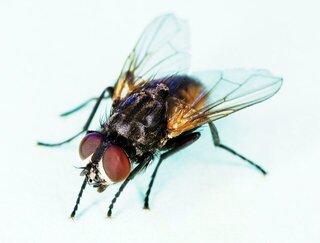
Having flies around your house can be annoying, and in some cases dangerous to your health. Being able to identify which type of fly is bothering you is the first step to getting rid of them.
Some characteristics you can look at to identify which type of fly you have are its length, its color and if it has patterns on its body. You can also look at where the flies are living, if they are near a trash bin, in your windows or near your drains. Knowing a fly’s life cycle will help you to see how long it will take for them to naturally die off, or if you need to eliminate them with other measures. The adult occurrence tells you what time of year you might see a type of fly.
You might also be interested in reading these two related articles “How to Get Rid of Drain Flies” and “How to Get Rid Of Mosquitoes“.
Check out the table below for a quick reference to identify different types of flies. Once you know what type of fly you have, you can read a more detailed description of each type.
| Fly Type | Description | Host Materia | Life Cycle | Adult Occurrence |
| House Fly | 6mm long; dull gray or black with four stripes on the thorax; 4th wing vein angled sharply | Manure, garbage, decaying organic matter | 7 to 45 days 6-8 generations per year | Year RoundMost abundant late summer to fall |
| Blow/Bottle Fly | 8 to 12mm long; shiny/metallic green, blue, bronze, black | Decaying organic matter, carcasses,garbage | 2-4 weeks Up to 5 generations per year | Summer to fall |
| Cheese Skipper | 4.4 to 5.2mm long; metallic blue to black, with bronze patches on the thorax, head and abdomen | Moldy cheese, low salt cured meats | 2-3 weeks Up to 6 generations per year | Warm and humid months |
| Cluster Fly | 8 to 10mm; dull gray and black with sluggish movements | Soil | 4-6 weeks 3-4 generations per year | Abundant in Spring and fall Hibernates in homes during winter, but will become active on warm days |
| Flesh Fly | 8 to 12mm long; gray and black checkerboard pattern on abdomen, red eyes | Carcasses, manure, garbage | 23 days 2-3 generations per year | Warm months |
| Drain Fly | 2.5 to 4.5mm long; mottled with a fuzzy appearance | Drains, wetlands | 21-27 days Up to 20 generations per year | Year Round Indoors, more common during warm months |
House Fly

This species is always associated with human activities. House flies are 6 to 7 mm long with black bodies and red eyes.
House flies are the most common species on poultry and pig farms, ranches and horse stables. They are a nuisance and can be dangerous if they carry diseases from place to place.
The top breeding sites for house flies in descending order are:
- Horse manure
- Human excrement
- Cow manure
- Fermenting vegetable matter
- Kitchen waste
House Fly Life Cycle
First Stage: Egg
A female can lay up to 500 1.2mm white eggs over several days. If the eggs stay moist, they will hatch after 8 to twenty hours.
Second Stage: Larva
House flies emerge as creamy-colored maggots, 3 to 9 mm long, and will grow to as large as 12 mm in four to 13 days. Larvae live and feed in the substrate they were laid in, often manure, before crawling out to find a dry place for their next stage.
Third Stage: Pupa
During pupation, house flies are about 8 mm long inside a case which turns from yellow to red, to brown and finally black as it ages. The pupal stage lasts two to six days under optimal conditions but could last as long as 27 days in cold weather.
Fourth Stage: Adult
Adult house flies live for 15 to 25 days. They can survive two to three days without food.
House flies are inactive at night, taking shelter in buildings, trees or bushes. They mainly eat sugar, but the female needs protein to make eggs.
Blow/ Bottle Flies
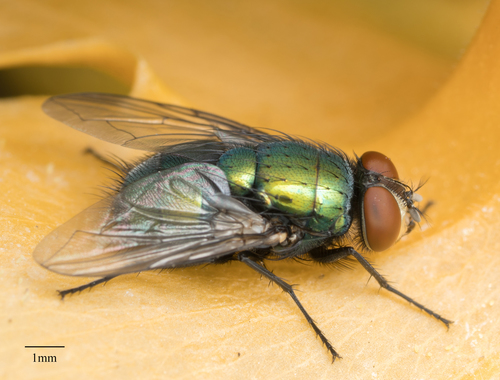
Shiny metallic-looking flies with large red eyes are called blow or bottle flies. Their bodies are green, bronze, blue or black, with translucent wings. These flies often congregate around windows and make a loud buzzing sound.
Blow or bottle flies are a critical part of the decay of animal carcasses, usually arriving soon after an animal dies. Besides animal carcasses, they lay eggs in any decaying organic matter, such as:
- Household garbage
- Animal manure
- Rotting vegetables
- Grass clippings
- Unkempt compost heaps
Bottle Fly Life Cycle
First Stage: Egg
Females lay 130 to 180 yellowish or pale-gray eggs at a time. The eggs hatch as soon as 10 hours to three days after being laid.
Second Stage: Larva
The larvae, commonly called maggots, are 10 to 14 millimeters long and pale white. This stage lasts two to ten days while the larvae feed on dead organic material.
Third Stage: Pupa
During pupation, the larva turns into a tough brown cocoon for about two weeks. The pupa stage occurs in a dry place.
Fourth Stage: Adult
Adults measure from eight to 12 mm. They become sexually mature after two weeks. Three to four generations of bottle or blow flies can complete in one year.
Cheese Skipper Fly
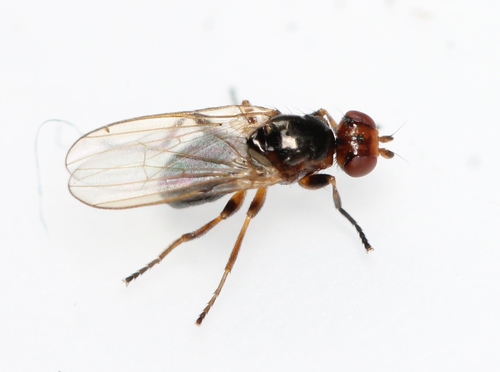
These flies are also called “ham skippers” for the ability of their larvae to jump. The adult flies are dark blue to black and metallic, with bronze patches on the thorax, head and abdomen.
Cheese skippers live all over the world. You might encounter cheese skippers near cured meats and moldy cheese.
The larvae of cheese skippers can survive being eaten by humans. If that happens, they can cause enteric (intestinal) myiasis, where they start feeding on living flesh.
Cheese Skipper Life Cycle
First Stage: Egg
The female lays 140 to 500 oval, smooth, pearly white eggs at a time in cheese or meat. The eggs hatch 23 to 54 hours after being laid.
Second Stage: Larva
The larval stage lasts up to 14 days, and the larvae look like 10mm yellowish/white worms. Cheese skipper larvae can jump through the air using their mouths as grapples, then jerking their body to propel themselves as they let go.
Third Stage: Pupa
The pupal stage lasts approximately 12 days after the larva finds a dark and dry location to make its cocoon. The pupae are 3 to 4mm long and dark brown.
Fourth Stage: Adult
Adults are 4.4 to 5.2mm long. They live for three to seven days.
Cluster Flies
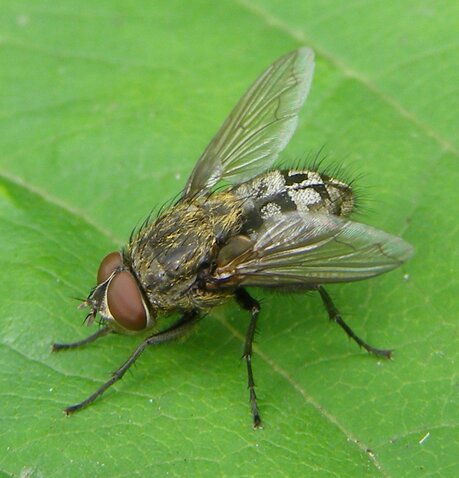
This type of fly tends to seek shelter in homes during the fall and stay all winter hibernating. They can be seen on warm winter days when they become active.
Cluster flies are larger than common house flies, measuring eight to 10 mm. Their abdomens have a black and silver checkered pattern.
The movements of cluster flies appear more sluggish than other flies. Their wings overlap across the abdomen when they rest.
Cluster Fly Life Cycle
First Stage: Egg
Females lay their eggs in the soil during spring. After three days, the eggs hatch.
Second Stage: Larva
Larvae seek out an earthworm to bore into and parasite. It lives off of the earthworm for two or three weeks.
Third Stage: Pupa
The larvae leave their earthworm host and become pupae in the soil. They stay in their cocoon for 11 to 14 days.
Fourth Stage: Adult
There are three to four generations of cluster flies per growing season. The final generation finds a place in the fall to hibernate for the winter and then lay the first generation in the spring.
Flesh Flies
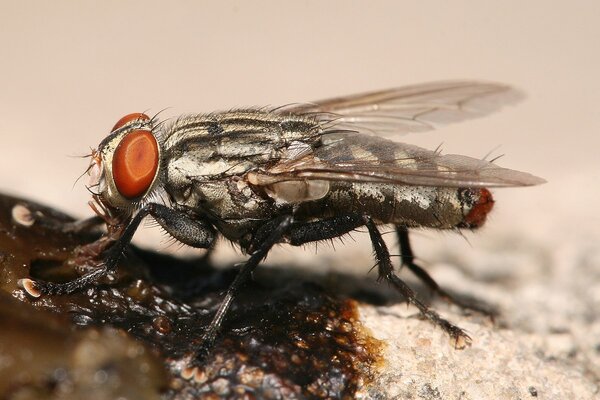
These flies have striking red eyes with a red dot on the tail. Flesh flies are 8 to 14 mm long and their bodies appear thin.
Flesh flies are black, with gray stripes. You can tell them apart from common house flies because they have three dark stripes on their thorax instead of four.
They are found all over the world near dead animals and waste. These flies are an important part of forensics because of their predictable life cycle after finding a dead body.
Flesh Flies Life Cycle
First Stage: Egg
Flesh fly eggs develop inside the adult female rather than in a carcass or other decaying matter. The behavior of eggs developing inside the female is called being larviparous.
Second Stage: Larva
The adult female deposits 20 to 40 live larvae into food sources such as dead animals, manure or garbage. Larvae feed for about four days.
Third Stage: Pupa
The pupae are reddish brown to dark orange and change with age. Pupation lasts 12 to 15 days under normal conditions, but some flesh flies could stay dormant until environmental factors are correct.
Fourth Stage: Adult
Adults start mating two to nine days after emerging from pupation. The entire flesh fly lifecycle is typically 23 days.
Drain Fly
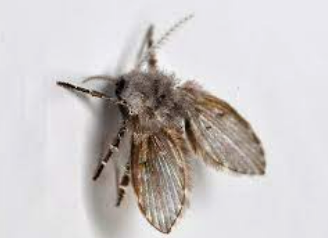
These flies appear short, stubby and hairy. You can normally see them in bathrooms or kitchens, near drains. They look like tiny moths, which is why they are sometimes called “moth flies.”
Drain flies don’t carry diseases nor do they bite. Large infestations of drain flies could irritate your lungs because they shed tiny hairs that can be breathed in.
Drain flies don’t have strong wing muscles, moving by short flights, jumps or running. Sewage filters are an ideal habitat for drain flies because they are large enough that the fly won’t get flushed down and provide ample food for the larvae.
Drain Fly Life Cycle
First Stage: Egg
Drain fly eggs must be laid on wet surfaces like damp soil or the sides of drains. Females lay masses of 15 to 40 translucent eggs that will hatch in under 48 hours at 70 degrees Fahrenheit.
Second Stage: Larva
Drain fly larvae resemble mosquito larvae and live in water but breathe air. The larvae can trap air bubbles and survive submerged for long periods. The larval stage lasts nine to 14 days.
Third Stage: Pupa
Pupae are yellow to brown, with twin respiratory trumpets resembling small horns. They need one to two days of development before moving on to the next stage.
Fourth Stage: Adult
Adults have a mottled appearance and are 2.5 to 4.5 mm long. They complete their life cycle in 21 to 27 days.
Final Thoughts
I hope this article is helpful. When dealing with pests, especially with those that cause disease, identifying the specific type you have is important.
Thank you for reading this article all the way to the end. Some related articles that you might find helpful are “How To Get Rid Of Fruit Flies“, and “How To Get Rid Of Houseflies“.